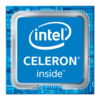Intel Celeron N4505 vs Intel Core 2 Duo SU9600 vs Intel Core 2 Duo T9800
Intel Celeron N4505
► remove from comparison
The Intel Celeron N4505 is a dual-core SoC of the Jasper Lake series that is primarily intended for inexpensive and small desktops and was announced in early 2021. The two Tremont CPU cores clock between 2 and 2.9 GHz (single core Burst) and offer no HyperThreading (SMT). The N4505 uses 1.5 MB L2 and 4 MB L3 cache. The chip is built with Intel's first-gen 10 nm process, just like Ice Lake family processors.
CPU Architecture
The processor architecture is called Tremont and a complete redesign compared to the old Golmont Plus cores in the predecessor. According to Intel, the single thread performance of a core could be improved by 30% on average (10 - 80% in all tests of SPECint and SPECfp).
Features
In addition to the dual-core CPU block, the SoC integrates a 16 EU Intel UHD Graphics GPU clocked from 450 - 750 MHz and a LPDDR4(x) dual channel memory controller (up to 16 GB and 2933 MHz). The chip now also partly integrates Wi-Fi 6 (Gig+), 8 PCIe 3.0 lanes, 14 USB 2.0/ 3.2 ports and two SATA 6.0 ports. The package got bigger and measures 35 x 24 mm (compared to 25 x 24 mm for the N5030 e.g.). The SoC is directly soldered to the mainboard (BGA) and can't be easily replaced.
Performance
The average N4505 in our database is just as fast as AMD's dual-core Athlon Silver 3050e and Intel's previous-gen Celeron N4100, as far as multi-thread benchmark scores are concerned. In other words, the Celeron is good for basic day-to-day activities but not much more than that, as of mid 2022.
Power consumption
This Celeron series SoC has a default TDP, also known as the long-term Power Limit, of 10 W, which is low enough to allow for passively cooled designs.
The N4505 is manufactured on the first-gen or the second-gen (no exact data available) 10 nm Intel process making for average, as of late 2022, energy efficiency.
Intel Core 2 Duo SU9600
► remove from comparisonThe Intel Core 2 Duo SU9600 is a power efficient subnotebook processor based on the Penryn 3M core. It features all functions of the Penryn core, like Virtualization (VT-x), Trusted Execution and Speedstep. Due to the low core clock, the performance is a bit limited, but should be sufficient for everyday tasks.
Intel Core 2 Duo T9800
► remove from comparison
The Intel Core 2 Duo T9800 was the top dual core CPU for laptops at the time of introduction. Later it was topped by the Core 2 Duo T9900 / X9100. Still the T9800 is a high end laptop CPU which is well suited for single and dual threaded applications.
Due to the high clock speed, the T9800 offers enough performance for demanding games (in 2009) and applications. On average, only faster dual cores (like the T9900 or fast Core i7) or Core i7 quad cores can be faster than the T9800.
The T9800 uses a Penryn (Montevina Update) core that features 2 integer units, 1 floating point unit, 1 load unit, and 1 store unit in a 14-stages long pipeline. Due to the Wide Dynamic Execution Technology, the core is able to simultaneously execute up to four instructions.
The integrated Enhanced Speedstep is able to downclock the core dynamically as low as 800 MHz to save power (in idle mode).
The Core 2 Duo T9800 can be used in a Socket P socket with 479 pins: Socket P / Micro Flip-Chip Pin Grid Array (Micro-FCPGA) requires 479-pin surface mount Zero Insertion Force (ZIF) socket (mPGA479M socket) or Micro Flip-Chip Ball Grid Array (Micro-FCBGA) for surface mount (479-ball)
| Model | Intel Celeron N4505 | Intel Core 2 Duo SU9600 | Intel Core 2 Duo T9800 | ||||||||||||||||||||||||||||||||
| Codename | Jasper Lake | Penryn | Penryn | ||||||||||||||||||||||||||||||||
| Series | Intel Jasper Lake | Intel Core 2 Duo | Intel Core 2 Duo | ||||||||||||||||||||||||||||||||
| Series: Core 2 Duo Penryn |
| ||||||||||||||||||||||||||||||||||
| Clock | 2000 - 2900 MHz | 1600 MHz | 2920 MHz | ||||||||||||||||||||||||||||||||
| L2 Cache | 1.5 MB | 3 MB | 6 MB | ||||||||||||||||||||||||||||||||
| L3 Cache | 4 MB | ||||||||||||||||||||||||||||||||||
| Cores / Threads | 2 / 2 | 2 / 2 | 2 / 2 | ||||||||||||||||||||||||||||||||
| TDP | 10 Watt | 10 Watt | 35 Watt | ||||||||||||||||||||||||||||||||
| Technology | 10 nm | 45 nm | 45 nm | ||||||||||||||||||||||||||||||||
| max. Temp. | 105 °C | 105 °C | 105 °C | ||||||||||||||||||||||||||||||||
| Socket | BGA1338 | BGA956 | Socket P (BGA479, PGA478) | ||||||||||||||||||||||||||||||||
| Features | DDR4-2933/LPDDR4x-2933 RAM, PCIe 3, GNA, MMX, SSE, SSE2, SSE3, SSSE3, SSE4.1, SSE4.2, SMEP, SMAP, EIST, TM1, TM2, Turbo, SST, AES-NI, RDRAND, RDSEED, SHA | Enhanced Speedstep, VT, TXT | Virtualization (VT-x), Trusted Execution, Intel 64, Enhanced Speedstep, Execute Disable Bit | ||||||||||||||||||||||||||||||||
| iGPU | Intel UHD Graphics (Jasper Lake 16 EU) (450 - 750 MHz) | ||||||||||||||||||||||||||||||||||
| Architecture | x86 | x86 | x86 | ||||||||||||||||||||||||||||||||
| Announced | |||||||||||||||||||||||||||||||||||
| Manufacturer | ark.intel.com | ark.intel.com | ark.intel.com | ||||||||||||||||||||||||||||||||
| FSB | 800 | 1066 | |||||||||||||||||||||||||||||||||
| L1 Cache | 128 KB | 128 KB | |||||||||||||||||||||||||||||||||
| Transistors | 410 Million | 410 Million | |||||||||||||||||||||||||||||||||
| Voltage | 0.775-1.1V V | 1-1.25 V V | |||||||||||||||||||||||||||||||||
| Die Size | 107 mm2 | 107 mm2 | |||||||||||||||||||||||||||||||||
| $289 U.S. | $530 U.S. |
Benchmarks
Average Benchmarks Intel Celeron N4505 → 0% n=0
Average Benchmarks Intel Core 2 Duo T9800 → 0% n=0
* Smaller numbers mean a higher performance
1 This benchmark is not used for the average calculation












